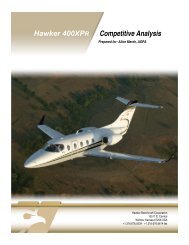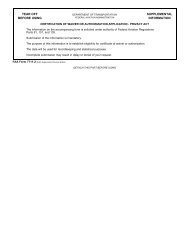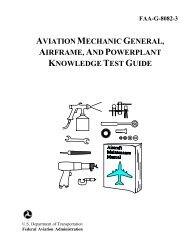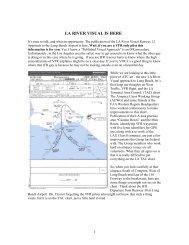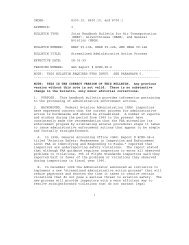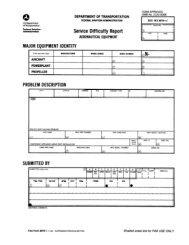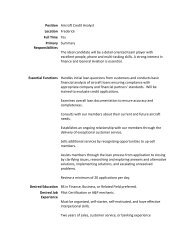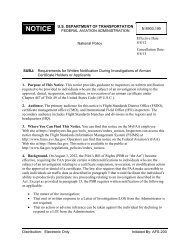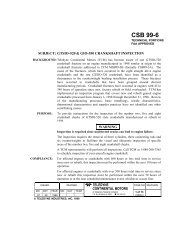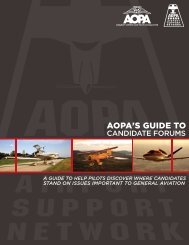2008 Nall Report - Aircraft Owners and Pilots Association
2008 Nall Report - Aircraft Owners and Pilots Association
2008 Nall Report - Aircraft Owners and Pilots Association
You also want an ePaper? Increase the reach of your titles
YUMPU automatically turns print PDFs into web optimized ePapers that Google loves.
ACCIDENT ANALYSIS<br />
with one exception, takes place in a relatively benign<br />
environment. There is little exposure to weather.<br />
When strong winds, icing, thunderstorms, or low ceilings<br />
are prevalent, most training ceases. That helps<br />
to keep instructional flying accidents low but shows<br />
up later as new pilots attempt to gain experience in<br />
areas where they have little exposure. Individual risk<br />
tolerance plays a large part in how safely a new pilot<br />
learns to deal with weather. One solution is for new<br />
pilots to continue with advanced training or fly with a<br />
seasoned mentor to learn weather <strong>and</strong> cross-country<br />
lessons that could not be easily done early on.<br />
The safety exceptions in instructional flying occur<br />
in high-density traffic around airports <strong>and</strong> practice<br />
areas. Instructional flights are involved in more<br />
potential midair collision environments. CFIs <strong>and</strong><br />
students involved in training are often distracted<br />
from scanning for traffic, <strong>and</strong> remembering to do<br />
so requires a significant effort. Additionally, there<br />
is a higher involvement in takeoff <strong>and</strong> l<strong>and</strong>ing accidents<br />
because training flights make so many takeoffs<br />
<strong>and</strong> l<strong>and</strong>ings.<br />
The 189 instructional accidents in 2007 were a 10<br />
percent increase from the 172 that occurred the<br />
previous year, but fewer were fatal: 15, down from<br />
21 in 2006.<br />
Pilot-related instructional accidents in 2007 totaled<br />
147, with 9 being fatal. This represents a<br />
significant decline from the 18 fatal instructional<br />
accidents in 2006.<br />
Other Working Flights<br />
75 total/25 fatal<br />
Almost three-quarters of all flight time in this<br />
category was logged by the professional crews of<br />
corporate flight departments. (This is distinct from<br />
business flights made by pilots who are not paid<br />
specifically to fly.) Aerial observation, including<br />
photography, surveys, pipeline <strong>and</strong> power line inspection,<br />
<strong>and</strong> traffic reporting accounted for most<br />
of the rest, but this category also includes uses as<br />
diverse as skydiving operations, banner tows, <strong>and</strong><br />
professional air shows.<br />
Accidents on corporate flights continued to be<br />
extremely rare in 2007, with only five in more than<br />
three million flight hours. Three of these were<br />
fatal. No other type of activity dominated the accident<br />
record. Not surprisingly, mishaps in air shows<br />
<strong>and</strong> air races were the most lethal, with fatalities<br />
Instructional<br />
Aerial<br />
application<br />
Other<br />
aerial work<br />
Personal<br />
Business<br />
Other*<br />
0 10 20 30 40 50 60 70 80<br />
11<br />
15.2%<br />
13.5% (189)<br />
5.9% (15)<br />
7.9%<br />
7.0%<br />
5.0% (70)<br />
2.7% (7)<br />
10.0%<br />
19.3%<br />
5.4% (75)<br />
9.8% (25)<br />
14.1%<br />
3.1% (44)<br />
4.3% (11)<br />
5.0%<br />
3.9% (54)<br />
4.3% (11)<br />
19.3%<br />
20.4%<br />
25.0%<br />
33.3%<br />
39.4%<br />
25.9%<br />
ATP<br />
11.7% (163)<br />
13.7% (35)<br />
20.7%<br />
Percent of flight time<br />
Percent of all accidents<br />
Percent of fatal accidents<br />
Percent lethality<br />
69.1% (965)<br />
72.9% (186)<br />
in Commercial eight out of 12. Fifteen accidents 29.2% occurred (408) in<br />
29.8% (76)<br />
public-use flights by governmental agencies, but<br />
37.9%<br />
only 47.8% (668)<br />
Private three were fatal, as were five of 12 accidents<br />
on ferry flights.<br />
0.4%<br />
Banner-tow <strong>and</strong> skydive operators<br />
each<br />
1.1% (16)<br />
Sport had one fatal accident out of seven. All told,<br />
1.6% (4)<br />
46 of the accidents on 15.1% working flights were Percent considered<br />
pilot-related, <strong>and</strong> 19 of these were fatal.<br />
of pilots<br />
Student<br />
8.2% (115)<br />
2.0% (5)<br />
Percent of all accidents<br />
None<br />
1.4% (19)<br />
Business 1.6% Flying (4)<br />
44 total/11 fatal<br />
Other/unknown<br />
Mechanical<br />
failures<br />
Other<br />
Fuel<br />
management<br />
Maneuvering<br />
0.6% (8)<br />
1.2(3)<br />
15.8% (219)<br />
7.5% (19)<br />
8.7%<br />
12.3% (170)<br />
16.7% (42)<br />
24.7%<br />
11.7% (162)<br />
Takeoff<br />
11.9% (30)<br />
<strong>and</strong> climb<br />
18.5%<br />
1.0% (14)<br />
Cruise 2.8% (7)<br />
Accidents by Type of Operation<br />
50.0%<br />
6.6% (91)<br />
20.2% (51)<br />
56.0%<br />
Figure 18<br />
* Includes test flights, positioning, <strong>and</strong> unknown.<br />
50.2% (128)<br />
Percent of fatal accidents<br />
General aviation is a key 19.4% component (271) of the national<br />
transportation system,<br />
CFI on board<br />
15.7%<br />
providing<br />
(40)<br />
service to many<br />
IFR cities pilot on board without adequate airline service. While the 47.2% (660)<br />
45.5% (116)<br />
airlines serve about 600 airports nationwide, GA<br />
10.5% (147)<br />
Second has pilot on direct board access to about 13.7% (35) 5,300 public-use airports.<br />
Many GA pilots rely on their airplanes for business<br />
transportation, 0 accounting 10 20 for 14.1 30 percent 40 of all 50 60<br />
GA flying in 2007. Business flying is proportionately<br />
much safer than other types of GA flying. <strong>Aircraft</strong><br />
used for business flights tend to be properly<br />
equipped to h<strong>and</strong>le challenging conditions, <strong>and</strong> the<br />
pilots more experienced <strong>and</strong> instrument rated.<br />
Percent of all accidents<br />
Percent of fatal accidents<br />
Business flying accounted for 44 accidents in 2007,<br />
6.5% (90)<br />
3.6% (9)<br />
up six from the<br />
10.0%<br />
year before. Eleven of those Lethality accidents<br />
were fatal, 3.6% (50) a<br />
percent<br />
Weather<br />
16.3%<br />
decrease<br />
(41)<br />
of four. Twenty-nine of<br />
the accidents on business flights in 2007 were considered<br />
Preflight pilot-related 1.2% (3) <strong>and</strong> nine of these were fatal;<br />
82.0%<br />
2.8% (39)<br />
<strong>and</strong> taxi 7.7%<br />
both represent decreases from the previous report.



